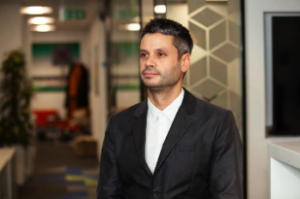Monsters exist, but they are too few in number to be truly dangerous. More dangerous are the common men, the functionaries ready to believe and to act without asking questions.”
Primo Levi
In his book, If This is A Man, first published in 1947 Primo Levi recounts the horrors he witnessed in Auschwitz. As his voice cuts through the decades and speaks to readers of today, it’s impossible to believe he is anything but one of us, feeling and thinking as we do. Yet running menacingly through the events he describes, is the systematic dismantling by the Nazis of all that made him and his fellow prisoners human.
In a recent documentary, exploring Germany’s reconciliation with its past, Eike Stegen of the House Wannsee Conference Museum in Berlin highlights the “bureaucratic monstrosity” of the Holocaust with a document produced by a Berlin electricity supplier. This form, which was signed and stamped by multiple employees of the company, sets out the money owed to the company by “evacuated” Jews. This example, like countless others, raises uncomfortable but important questions – how could people in a scientifically and culturally advanced democracy have fallen for ideas that were so wrong? What does their participation and complicity, however big or small, in the dehumanisation and murder of their neighbours and colleagues mean for the human race today?
While the Holocaust serves as a poignant reminder of our capacity for great cruelty, it also demonstrates our propensity for breath-taking compassion and bravery, even for those we do not know. There are countless stories of individuals who stood up to protect Jews and other victims of the Holocaust in one way or another. Some galvanized the Kindertransport[1] project or sheltered at-risk families, while others took on the simple but significant task of simply speaking out when Jews were dehumanised.
Those who have explored the history of the Holocaust have generally concluded that it is as much an exploration of our own psychology as it is about the documentation of facts and incidents.[2] Some of the most famous experiments in psychology – the Milgrim shock experiment, Asch’s social conformity experiment, Zimbardo’s Stanford prison experiment – all challenged the supposition that the Holocaust was created by “monsters” alone, and showed the effect of situational factors, social influence and authority on the actions of “common men”.
Behavioural science can also help us understand how we see and respond to other groups. For example, it shows us that the building of discrimination and persecution can be incremental in nature, but once social dynamics take hold, they can be hard to shift. Negative group dynamics, such as a history of a devalued group and the dehumanisation of out-groups, appear across almost all models of the evolution of genocide.[3] [4] [5] [6] Indeed, the geographical distribution of pogroms against Jews in the 14th century was found to be a robust predictor of violence and xenophobia against Jews in the 1920s and 1930s in Germany.[7]
This persistence of anti-Semitism over centuries suggests that improving intergroup relations today, and taking immediate action to quell negative dynamics when they first emerge, might have preventative effects many years, or even centuries, in the future. Negative group dynamics are, at their root, stark examples of our natural tendency to identify with a group and behave preferentially towards those within it. But despite this tendency, our concept of group identity, and who falls within it, can be malleable and, at BIT we have started to design interventions to build empathy and reduce prejudice across group lines.
To many, it may seem impossible to think that the Holocaust could happen again in Europe. But, returning to Primo Levi, “conscience can be seduced and obscured again: even our consciences. For this reason, it is the duty of everyone to meditate on what happened.” So as we seek to keep the history of the Holocaust alive, we should also think about how we can reach into our society, our schools and workplaces, to feel its enduring relevance and warning, urging us to understand ourselves so that we can fulfil our intrinsic potential for compassion and bravery.
[1] The Kindertransport was an organised rescue effort in which roughly 10,000 (predominantly) Jewish children were rescued from Nazi occupied territories and transported to Britain, where they were subsequently housed and adopted by families.
[2] Fromm, E (1973). The anatomy of human destructiveness. New York, NY: Holt, Rinehart and Winston
[3] Staub, E. (1989). The roots of evil: The origins of genocide and other group violence. Cambridge, UK: Cambridge University Press.
[4] Stanton, G. H. (1998). The 8 stages of genocide. Genocide Watch, 1.
[5] Moshman, D. (2007). Us and them: Identity and genocide. Identity: An International Journal of Theory and Research, 7(2), 115-135.
[6] Fein, H. (1979). Accounting for genocide: Victims and survivors of the Holocaust. New York: Free Press.
[7] Voigtlaender, N., & Voth, H.-J. (2011). Persecution Perpetuated: The Medieval Origins of Anti-Semitic Violence in Nazi Germany. NBER Working Paper.





